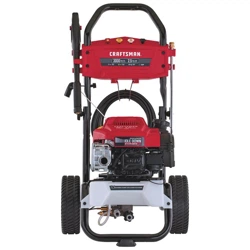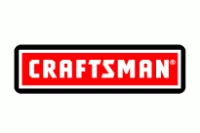Documents: Go to download!
User Manual
- User Manual - (English, Spanish)
- Warranty Guide - (English)
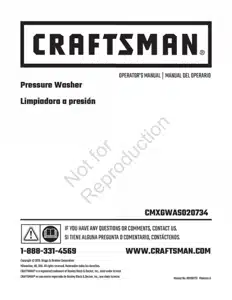
- Assembly
- Features and Controls.
- Operation
- Maintenance
- Troubleshooting
Table of contents
Operator's Manual Pressure Washer
Assembly
Read entire operator's manual before you attempt to assemble or operate your new pressure washer.
Your pressure washer requires some assembly and is ready for use after it has been properly serviced with the recommended oil and fuel.
If you have any problems with the assembly of your Pressure washer, please call the pressure washer helpline. If calling for assistance, please have the model, revision, and serial number from the identification label available.
Unpack Pressure Washer
- Remove the parts bag, accessories, and inserts included with pressure washer.
- Open carton completely by cutting each corner from top to bottom.
- Ensure you have all included items prior to assembly.
Items in the carton include:
- Main Unit
- Handle
- High Pressure Hose
- Spray Gun
- Nozzle Extension with Quick Connect
- Plastic Accessory Tray
- Hose Hook Wireform
- Oil Pouch
- Parts Bag (which includes the following):
- Operator's Manual
- Bag of 4 Multi-Colored Quick Connect Spray Tips
- Rubber Strap
- Hardware Kit (which includes):
- Carriage Bolts (2)
- Plastic Knobs (2)
- Tree Clips (4)
- Rope Guide
- Plastic Knob
Attach Handle and Accessory Tray
- Place handle (A) onto handle supports connected to main unit. Make sure holes in handle align with holes on handle supports.
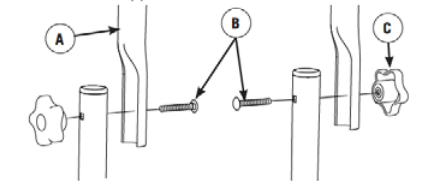
- Insert carriage bolts (B) through holes from inside of unit and attach a plastic knob (C) from outside of unit. Tighten by hand.
- Place accessory tray (D) over holes (E) on handle (viewing from front of unit). Push tree clips (F) into the holes until they sit flat against the accessory tray.

- Attach rope guide (G) through handle with plastic knob (H). Tighten by hand. Route engine recoil rope through guide.
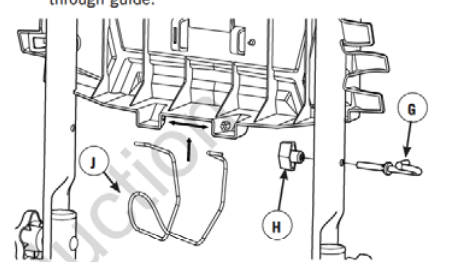
- Squeeze hose hook wireform (J) together and insert into grooves at bottom of accessory tray.
Add Engine Oil
- Place pressure washer on a flat. level surface.
- Clean area around oil fill and remove yellow oil fill cap/dipstick.
- Hold neck of supplied oi! pouch and remove cap.
- Slowly pour contents of oil pouch into oil fill opening. Checking oil level frequently. fill to FULL mark (top hole) on dipstick.
 . NOTICE: Pause to permit oil to settle. Wipe dipstick clean each time oil level is checked. DO NOT overfill. NOTICE: Improper treatment of pressure washer could damage it and shorten its life. DO NOT attempt to crank or start the engine before it has been properly serviced with the recommended oil. This could result in an engine failure.
. NOTICE: Pause to permit oil to settle. Wipe dipstick clean each time oil level is checked. DO NOT overfill. NOTICE: Improper treatment of pressure washer could damage it and shorten its life. DO NOT attempt to crank or start the engine before it has been properly serviced with the recommended oil. This could result in an engine failure. - Replace oil fill cap/dipstick and fully tighten.
Add Fuel
Fuel must meet these requirements:
- Clean. fresh. unleaded gasoline.
- A minimum of 87 octane/87 AKI (91 RON). For high altitude use, see High Altitude.
- Gasoline with up to 10% ethanol (gasohol) is acceptable.
NOTICE: Use of unapproved fuels could damage pressure washer and voids warranty.
- DO NOT use unapproved gasoline such as £15 and E85.
- DO NOT mix oil in gasoline or modify engine to run on alternate fuels.
To protect the fuel system from gum formation. mix in a fuel stabilizer when adding fuel. See Storage. All fuel is not the same. If you experience starting or performance problems after using fuel. switch to a different fuel provider or change brands. This engine is certified to operate on gasoline.
The emission control system for this engine is EM (Engine Modifications).
WARNING: Fuel and its vapors are extremely flammable and explosive which could cause burns. fire or explosion resulting a in death or serious injury.
WHEN ADDING FUEL
- Turn pressure washer engine OFF and let it cool at least 2 minutes before removing fuel cap. Loosen cap slowly to relieve pressure in tank.
- Fill fuel tank outdoors.
- DO NOT overfill tank. Allow space for fuel expansion. If fuel spills, wait until it evaporates before starting engine.
- Keep fuel away from sparks, open flames, pilot lights, heat. and other ignition sources.
- Check fuel lines, tank, cap and fittings frequently for cracks or leaks. Replace if necessary.
- DO NOT light a cigarette or smoke.
1. Clean area around fuel fill cap. remove'cap.
2. Slowly add regular unleaded fuel (A) to fuel tank (B). Be careful not to overfill. To allow for fuel expansion. do not fill above the bottom of the fuel tank neck.

3. Install fuel cap and let any spilled fuel evaporate before starting engine.
High Altitude
- At altitudes over 5. 00 ft. (1524 m), a minimum 85 octane / 85 AKI (89 RON) gasoline is acceptable. To remain emissions compliant, high altitude adjustment is required. Operation without this adjustment will cause decreased performance, increased fuel consumption. and increased emissions. See an Authorized Briggs & Stratton dealer for high altitude adjustment information. Operation of the engine at altitudes below 2. 00 ft. (762 m) with the high altitude kit is not recommended.
Lubricate O-Rings
Lubrication of o-rings is extremely important for installation and operation. The use of a lubricant (petroleum or synthetic grease) during assembly helps seat o-rings properly and provides an improved seal. It also helps protect the o-ring from damage by abrasion. pinching or cutting and extends the life of the o-ring.
NOTICE ALWAYS apply a small amount of lubricant on co-rings prior to assembling the garden hose to the pump (A). high pressure hose (B). spray gun (C). and nozzle extension (D).
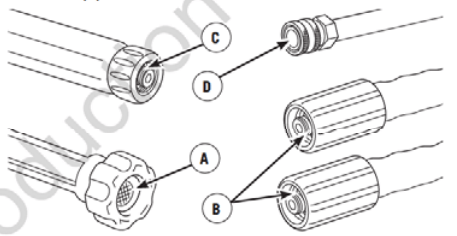
Lubricate all connections shown. following these instructions:
- Inspect and clean connecting surfaces prior to lubrication and assembly.
- Use lubricants sparingly during assembly; a light film is all that is required.
- Use a small brush or cotton swab to apply grease directly to o-rings where they are not accessible (QC fii. M22 fitting).
Connect Hose and Water Supply to Pump
NOTICE: DO NOT run the pump without the water supply connected and turned on.
- Damage to equipment resulting from failure to follow this instruction will void warranty.
1. Uncoil high pressure hose and attach one end of hose to base of spray gun. Tighten by hand.

WARNING: The high pressure stream of water that this equipment produces could cut through skin and its underlying tissues. resulting in serious ) injury and possible amputation.
- NEVER connect high pressure hose to nozzle extension.
- Keep high pressure hose connected to pump and spray gun while system is pressurized.
- Always be certain spray gun. nozzles and accessories are comectly attached.
2. Attach other end of high pressure hose to high pressure outlet on pump. Tighten by hand.
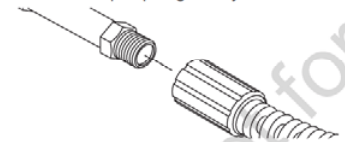
3. Run water through your garden hose for 30 seconds to clean out any debris.
NOTICE: DO NOT siphon standing water for the water supply. Use ONLY cold water (lessithan 100°F (38°C).
4. Before connecting garden hose to water inlet, inspect inlet screen (A). Clean screen if it contains.debris or have it replaced if damaged. DO NOT tun pressure washer if inlet screen is damaged.

NOTICE: Using a One Way Valve (vacuum breaker or check valve) at pump inlet could cause pump or inlet connector damage.
- There MUST be at least 10 ft. (3 m) of unrestricted garden hose between the pressure washer inlet and any device. such as a vacuum breaker or check valve.
- Damage to equipment resulting from failure to follow this instruction will void warranty.
5. Connect the garden hose (not to exceed 50 ft. (15 m) in length) to the water inlet. Tighten by hand.
WARNING: Risk of eye injury.- Spray could splash back or propel objects resulting in serious injury.
- Always wear indirect vented (chemical splash) safety goggles marked to comply with ANSI 287.1 when using or in vicinity of this equipment.
- NEVER substitute safety glasses or dry-condition goggles for indirect vented safety goggles.
6. Turn ON the water. press red button (B) on the gun and squeeze the trigger to purge the pump system of air and impurities.
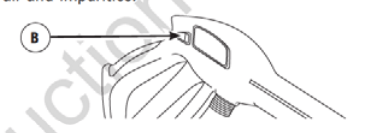
Checklist Before Starting Engine: Review the unit's assembly to ensure you have performed all of the following.
- 1Be sure to read Operator Safety and Operation before using pressure washer.
- Make sure handle is in place and secure.
- Check that oil has been added to proper level in the engine crankcase.
- Add proper fuel to fuel tank.
- Check for properly tightened hose connections.
- Check to make sure there are no kinks. cuts. or damage to high pressure hose.
- Provide a proper water supply at an adequate flow.
Features and Controls.
Read this Operator's Manual and safety rules before operating your pressure washer.
Compare the illustrations with your pressure washer. to familiarize yourself with the locations of various controls and adjustments. Save this manual for future reference.
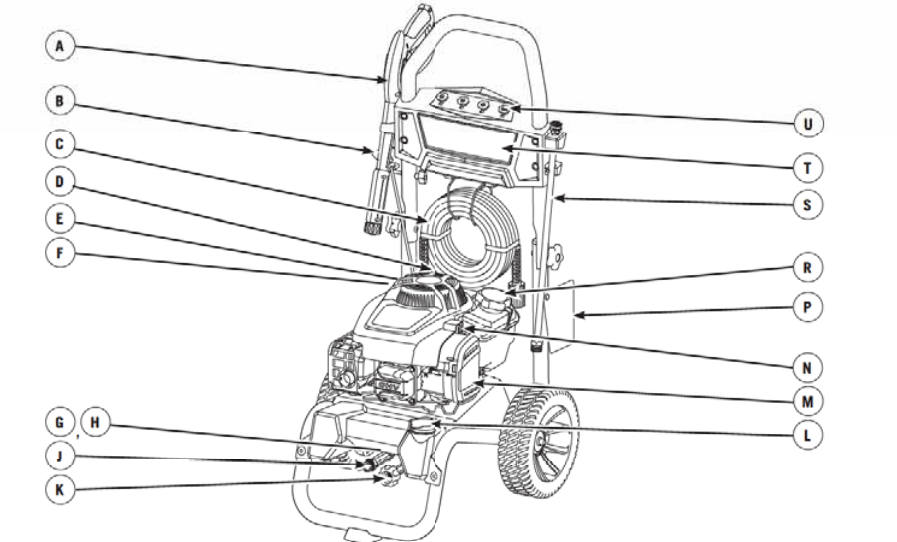
A- Spray Gun — Controls the application of water onto cleaning surface with trigger device. Includes trigger lock.
B - Recoil Starter — Used for starting the engine manually.
C - High Pressure Hose — Connect one end to water pump and the other end to spray gun.
D - Oil Fill/Dipstick — Check and fill with oil here.
E - Engine Identification — Provides model, type and code of engine. Please have these readily available if calling for assistance.
F - Identification Label — Provides model and serial number of pressure washer. Please have these readily available if calling for assistance.
G - Pump — Develops high pressure.
H - Automatic Cool Down System — Cycles water through pump when water reaches above 125°F (51°C). Warm water will discharge from pump onto ground. This system prevents internal pump damage.
J - High Pressure Outlet — Connection for high pressure hose.
K - Water Inlet — Connection for garden hose.
L - Detergent Tank — Use to hold up to one half gallon (1.9 I) of pressure washer detergent.
M - Air Filter — Protects engine by filtering dust and debris out of intake air.
N - Engine Rocker Switch — Push this switch to ON (1) posi before using recoil starter. Push switch to OFF (0) position for shutting off engine.
P - Warning/Operating Instructions Tag — Identifies hazards and proper procedure to start/stop pressure washer.
R - Fuel Tank — Fill tank with regular unleaded fuel. Always leave room for fuel expansion.
S - Nozzle Extension with Quick Connect — Allows you to switch between four different spray tips.
T - Accessory Tray — Provides convenient storage for standard and optional accessories. such as brushes. turbo wands. etc.
U - Spray Tips — Detergent. 0°. 15° and 40°: for various high pressure cleaning applications.
Operation
Pressure Washer Location - Carbon Monoxide Poisoning
WARNING: POISONOUS GAS HAZARD. Engine exhaust contains carbon monoxide, a poisonous gas that could kill you in minutes. You CANNOT smell it, see it, or taste it. Even if you do not smell exhaust fumes, you could still be exposed to carbon monoxide gas.
- Operate this product ONLY outside far away from windows, doors and vents to reduce the risk of carbon monoxide gas from accumulating and potentially being drawn towards occupied spaces.
- Install battery-operated carbon monoxide alarms or plug-in carbon monoxide alarms with battery back-up according to the manufacturer's instructions. Smoke alarms cannot detect carbon monoxide gas.
- DO NOT run this product inside homes, garages, basements, crawispaces. sheds. or other partially-enclosed spaces even if using fans or opening doors and windows for ventilation. Carbon monoxide can quickly build up in these spaces and can linger for hours, even after this product has shut off.
- ALWAYS place this product downwind and point the engine exhaust away from occupied spaces.
If you start to feel sick. dizzy. or weak while using this product. get to fresh air RIGHT AWAY. See a doctor. You may have carbon monoxide poisoning.
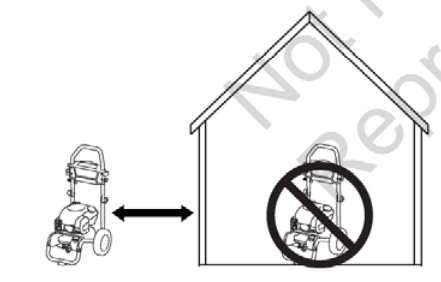
Risk of Fire Clearances: WARNING - Exhaust heat/gases could ignite combustibles, structures or damage fuel tank causing a fire, resulting in death or serious injury.
- Keep at least 5 ft. (1.5 m) clearance on all sides of pressure washer including overhead.
How to Start Your Pressure Washer
To start your pressure washer for the first time. follow these instructions step-by-step. This starting information also applies if you have let the pressure washer sit idle for at least a day.
- Place pressure washer near an outside water source capable of supplying water at a flow rate greater than 3.5 gallons (13.25 |) per minute and no less than 20 PSI (1.3 BAR) at pressure washer end of garden hose. DO NOT siphon supply water.
- Check that high pressure hose is tightly connected to spray gun and pump. See Assembly section.
- Make sure unit is in a level position.
- Connect garden hose to water inlet on pressure washer pump. NOTICE: DO NOT run the pump without the water supply connected and turned on. Damage to equipment resulting from failure to follow this instruction will void warranty.
- Turn ON water. point gun in a safe direction. press red button and squeeze trigger to purge pump system of air and impurities.
- Attach nozzle extension to spray gun. Tighten by hand.

- Choose spray tip you want to use. pull back on collar of nozzle extension. insert spray tip and release collar. Tug on spray tip to make sure it is securely in place. See How to Use Spray Tips.
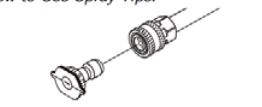
- Push engine rocker switch (A) to ON (I) position.
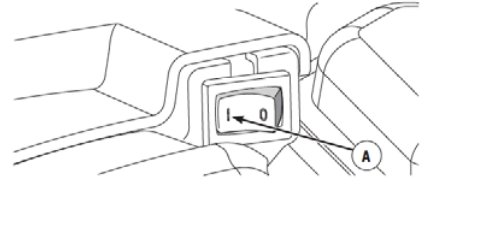
NOTICE: Before starting the pressure washer. be sure you are wearing safety goggles as described.
WARNING - Risk of eye injury. Spray could splash back or propel objects resulting in serious injury.
- Always wear indirect vented (chemical splash) safety goggles marked to comply with ANS! 287.1 when using or in vicinity of this equipment.
- NEVER substitute safety glasses or dry-condition goggles for indirect vented safety goggles.
NOTICE: This unit is equipped with a ReadyStart engine. A ReadyStart engine means there is no priming or choking required.
9. When starting engine, position yourself as recommended and grasp starter grip handle and pull slowly until you feel some resistance. Then pull rapidly to start engine.
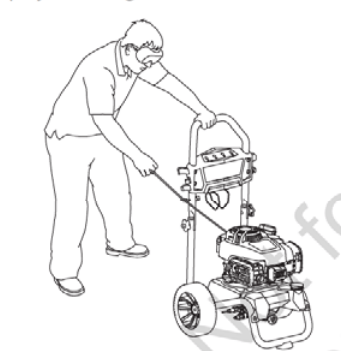
WARNING: Starter cord kickback (rapid retraction) will pull hand and arm toward engine faster than you can let go which could cause broken bones. fractures. bruises. or sprains resulting in serious injury. NEVER pull starter cord without first relieving spray gun pressure.
- When starting engine. pull cord slowly until resistance is felt and then pull rapidly to avoid kickback.
- After each starting attempt. where engine fails to run, always point spray gun in safe direction. press red button and squeeze spray gun trigger to release high pressure.
- Firmly grasp spray gun with both hands when using high pressure spray to avoid injury when spray gun kicks back.
10. Return starter grip handle slowly. DO NOT let rope “snap back” against starter.
NOTICE: Pressure washer is equipped with an automatic idle control. The idle contro! will lower engine speed when spray gun trigger is released.
WARNING The high pressure stream of water that this equipment produces could cut through skin and its underlying tissues, resulting in serious injury and possible amputation. Spray gun traps high water pressure. even when engine is stopped and water is disconnected, which could result in serious injury.
- D0 NOT allow CHILDREN to operate pressure washer.
- Keep high pressure hose connected to pump and spray gun while system is pressurized.
- NEVER aim spray gun at people, animals, or plants.
- DO NOT secure spray gun in open position.
- DO NOT leave spray gun unattended while machine is running.
- NEVER use a spray gun which does not have a trigger lock or trigger guard in place and in working order
- Always be certain spray gun. nozzles and accessories are correctly attached.
WARNING - Exhaust heat/gases could ignite combustibles, structures or damage fuel li tank causing a fire. resulting in death or serious injury.Contact with muffler area could cause burns resulting in serious injury.
- DO NOT touch hot parts and AVOID hot exhaust gases.
- Allow equipment to cool before touching.
- Keep at least 5 ft. (1.5 m) of clearance on all sides of pressure washer including overhead.
- It is a violation of California Public Resource Code. Section 4442, to use or operate the engine on any forest-covered, brush-covered. or grass-covered land unless the exhaust system is equipped with a spark arrester. as defined in Section 4442, maintained in effective working order. Other states or federal jurisdictions may have similar laws. Contact the original equipment manufacturer. retailer. or dealer to obtain a spark arrester designed for the exhaust system installed on this engine.
- Replacement parts must be the same and installed in the same position as the original parts.
How to Stop Your Pressure Washer
- Release spray gun trigger and let engine idle for two minutes.
- Push engine rocker switch to OFF (0) position.
- ALWAYS point gun in a safe direction and press red button and squeeze spray gun trigger to release retained high water pressure.
WARNING: The high pressure stream of water that this equipment produces could cut through skin and its underlying tissues. resulting in serious A injury and possible amputation. Spray gun traps high water pressure. even when engine is stopped and water is disconnected. which could result in serious injury.
- Keep high pressure hose connected to pump and spray gun while system is pressurized.
- ALWAYS point spray gun in safe direction. press red button and squeeze spray gun trigger to release high pressure. every time you stop engine.
How to Use Accessory Tray
The unit is equipped with an accessory tray with places to store your spray gun, nozzle extension, high pressure hose and quick connect spray tips.
- Place nozzle extension in slots on left side of accessory tray (viewing from rear of unit) and snap in.
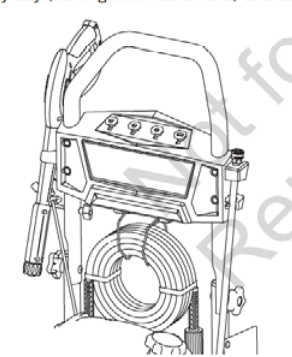
- Place spray gun through grooves on right side of accessory tray.
- Insert multi-colored spray tips in holes provided on front of accessory tray.
- Wrap high pressure hose and hang on hook of accessory tray.
NOTICE: There is also a slot for storing a can of Pump Saver on the back. See Pump Saver Storage.
How to Use Spray Tips
- The quick-connect on the nozzle extension allows you to switch between four different quick connect spray tips. Spray tips can be changed while pressure washer is running once spray gun trigger lock is engaged. The spray tips vary the spray pattern as shown.
Follow these instructions to change spray tips:
1. Pull back collar on quick-connect and pull current spray tip off. Store spray tips in holes provided on the accessory tray.
WARNING: The high pressure stream of water that this equipment produces could cut through skin d its underlying tissues. resulting in serious jury and possible amputation.
- NEVER exchange spray tips without the trigger lock being engaged on the spray gun.
- DO NOT twist spray tips while spraying.
2. Select desired spray tip
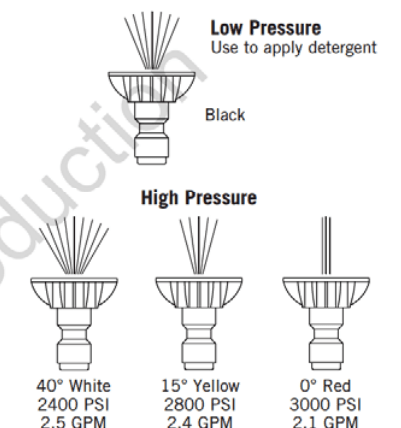
- For delicate rinse, for gentle cleaning got cars/ trucks, boats. RV's. io furniture, equipment, etc. select white 40° spray ray tip.
- For general rinsing. ideal for most all purpose cleaning such as home siding. brick patios, wood decks, driveways and sidewalks, garage floors. etc.. select yellow 15° spray tip.
- For maximum rinsing, for stubborn or hard to reach surface such as second story surfaces, paint removal, oil stains, rust removal or other stubborn substances (tar, gum, grease, wax, etc.), select red O° spray tip.
- To apply detergent. applies project specific cleaners to help break down stubborn dirt and grime on a variety of surfaces. select black detergent spray tip.
3. Pull back on collar, insert new spray tip and release collar. Tug on spray tip to make sure it is securely in place.
Usage Tips
- For most effective cleaning, keep spray tip from 8 to 24 in. away from cleaning surface.
- If you get spray tip too close, especially using a high pressure spray tip, you may damage surface being cleaned. DO NOT get closer than 6 in. when cleaning tires.
Applying Detergent
To apply detergent, follow these steps:
- Review use of spray tips.
- Prepare detergent solution as required by job.
- Pour detergent into cleaning tank.
- Make sure black detergent spray tip is installed.
- Make sure garden hose Is connected to waterr Inlet. Check that high pressure hose is connected to spray gun and pump. Turn on water.
- Start engine following instructions How to Start Your Pressure Washer.
- Apply detergent to a dry surface, starting at lower portion of area to be washed and work upward, using long, even, overlapping strokes.
- Allow detergent to "soak in" for 3-5 minutes before washing and rinsing. Reapply as needed to prevent surface from drying. DO NOT allow detergent to dry on (prevents streaking).
Pressure Washer Rinsing
For Rinsing:
1. Remove black detergent spray tip from nozzle extension.
2. Select and install desired high pressure spray tip following instructions How to Use Spray Tips.
3. Keep the spray gun a safe distance from the area you plan to spray.
WARNING: Kickback from spray gun could cause you to fall resulting in death or serious injury.
- Operate pressure washer from a stable surface.
- Be extremely careful if you must use the pressure washer from a ladder. scaffolding. or any other similar location.
- Firmly grasp spray gun with both hands when using high pressure spray to avoid injury when spray gun kicks back.
Automatic Cool Down System (Thermal Relief)
- If you run the engine on your pressure washer for 3-5 minutes without pressing the trigger on the spray gun. circulating water in the pump can reach temperatures above 125%155°F (51°-68°C). The system engages to cool the pump by discharging the warm water onto the ground.
4. Apply a high pressure spray to a small area, then check the surface for damage. If no damage is found, it is okay to continue cleaning.
5. Start at the top of the area to be rinsed, working down with same overlapping strokes as you used for washing and applying detergent.
Maintenance
Maintenance Schedule
Follow the hourly or calendar intervals, whichever occurs first. More frequent service is required when operating in adverse conditions noted below.
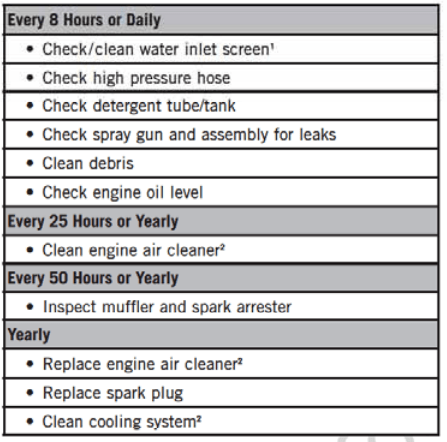
1 Clean if clogged. Replace it perforated or torn.
2 Service more often under dity or dusty conditions.
General Recommendations
- Regular maintenance will improve the performance and extend the life of the pressure washer. See any qualified dealer for service.
- The pressure washer's warranty does not cover items that have been subjected to operator abuse or negligence. To receive full value from the warranty. the operator must maintain the pressure washer as instructed in this manual, including proper storage as detailed in Winter Storage and Long Term Storage.
- NOTICE: Should you have questions about replacing components on your pressure washer. please call for assistance.
- Some adjustments will need to be made periodically to properly maintain vour pressure washer.
- All service and adjustments should be made at least once each season. A new spark plug and clean air filter assure proper fuel-air mixture and help your engine run better and last longer. Follow the requirements in the Maintenance Schedule chart above.
Pump Oil
- DO NOT attempt any oil maintenance on this pump. The pump is pre-lubricated and sealed from the factory. requiring no additional maintenance for the life of the pump.
Emissions Control
- Maintenance. replacement, or repair of the emissions contro! devices and systems may be performed by any non-road engine repair establishment or individual. However to obtain "no charge” emissions control service, the work must be performed by a factory authorized dealer. See the Emissions Warranty.
Before Each Use
- Check engine oil level.
- Clean debris.
- Check water inlet screen for damage.
- Check high pressure hose for leaks.
- Check detergent tube for damage.
- Check spray gun and nozzle extension assembly for leaks.
- Rinse out garden hose to flush out debris.
Pressure Washer Maintenance
Clean Debris
- Daily or before use. clean accumulated debris from pressure washer. Keep linkage. spring and controls clean.Keep area around and behind muffler free from any combustible, debris, Inspect cooling air slots and openings on’the pressure washer. These openings must be kept clean and unobstructed.
- Pressure washer parts should be kept clean to reduce the isk of overheating and ignition of accumulated debris.
- Use a damp cloth to wipe exterior surfaces clean.
NOTICE : Improper treatment of pressure washer could damage it and shorten its life.
- DO NOT insert any objects through cooling slots.
- Use a soft bristle brush to loosen caked on dirt, oil, etc.
- Use a vacuum cleaner to pick up loose dirt and debris.
Check and Clean Inlet Screen
- Examine the screen on the pump's water inlet. Clean it if the screen is clogged or replace it if screen is damaged.
Check High Pressure Hose
- WARNING:The high pressure stream of water that this equipment produces could cut through skin nd its underlying tissues. resulting in serious injury and possible amputation.
- NEVER repair high pressure hose. Replace it.
- Replacement hose rating MUST equal or exceed maximum pressure rating of unit.
- The high pressure hose can develop leaks from wear, kinking, or abuse. Inspect the hose each time before using it. Check for cuts, leaks, abrasions or bulging of cover, damage or movement of couplings. If any of these conditions exist, replace the hose immediately.
Check Detergent Tube/Tank
- Examine detergent tank and detergent tube and clean if clogged. The tube should fit tightly on the barbed fitting of the pump and tank. Examine the tube for leaks or tears. Replace the tank or tube if either is damaged.
Detergent Siphoning Check Ball
Occasionally check ball in detergent siphoning system may become stuck from storage, dried soap, or minerals in water. The check ball can be freed by performing the following.
WARNING - Risk of eye injury.Spray could splash back or propel objects: resulting in serious injury.
- Always wear indirect vented (chemical splash) safety goggles marked to comply with ANSI 287.1 when using or in vicinity of this equipment.
- NEVER substitute satety glasses or dry-condition goggles for indirect vented safety goggles.
- Shut OFF engine and turn off water supply.
- ALWAYS point spray gun in a safe direction, press red button and squeeze spray gun trigger to release retained high water pressure. WARNING: The high pressure stream of water that this equipment produces could cut through skin and its underlying tissues. resulting in serious injury and possible amputation.Spray gun traps high water pressure. even when engine is stopped and water is disconnected. which could result in serious injury.
- Keep high pressure hose connected to pump and spray gun while system is pressurized.
- ALWAYS point spray gun in safe direction, . press red button and squeeze spray gun trigger to release high pressure, every time you stop engine.
- Remove detergent hose from barbed fitting on pump.
- Using a firm, blunt object 7/64" in diameter or smaller, by at least 1" long, such as an Allen wrench, slowly insert the object into the barbed fitting until you meet resistance. This resistance is the check ball.
- Slowly push down until you feel the ball move slightly, push no more than 1/8". Slight pressure may be required to free the ball.
- Repeat steps 4 and 5 if necessary.
- Reinstall detergent hose onto barb fitting.
- Treat with Pump Saver as described in Protecting the Pump during storage to prevent reoccurrence.
Check Spray Gun
- Examine the hose connection to the spray gun and make sure it is secure. Test the trigger by pressing the red button and making sure the trigger "springs back" into place when you release it. You should not be able to press the trigger without pressing the red button. Replace spray gun immediately if it fails any of these tests.
Spray Tip Maintenance
A pulsing sensation felt while squeezing the spray gun trigger may be caused by excessive pump pressure. The principal cause of excessive pump pressure is a spray tip clogged or restricted with foreign materials. such as dirt. etc. To correct the problem, immediately clean the spray tip following these instructions:
1. Shut OFF engine and turn off water supply.
2. ALWAYS point spray gun in a safe direction, press red button and squeeze spray gun trigger to release retained high water pressure.
WARNING: The high pressure stream of water that this equipment produces could cut through skin ind its underlying tissues. resulting in serious injury and possible amputation.
Spray gun traps high water pressure. even when engine is stopped and water is disconnected. which could result in serious injury.
- Keep high pressure hose connected to pump and spray gun while system is pressurized.
- ALWAYS point spray gun in safe direction, press red button and squeeze spray gun trigger to release high pressure, every time you stop engine.
3. Remove spray tip from end of nozzle extension.
4. Use a small paper clip to free any foreign material clogging or restricting spray tip (A).

5. Remove nozzle extension from spray gun.
See other models: CMXGWAS020735 CMXGWAS020736 030733 CMXGIAC2200 CMXGGAS030734
6. Using a garden hose, remove additional debris by back flushing water through nozzle extension. Back flush between 30 to 60 seconds.

7. Reinstall spray tip into nozzle extension.
8. Reconnect nozzle extension to spray gun.
9. Make sure garden hose is connected to water inlet. Check that high pressure hose is connected to spray gun and pump. Turn on water.
10. Start engine following instructions How to Start Your
Pressure Washer.
11. Test pressure washer by operating with each quick connect spray tip.
O-Ring Maintenance
Purchase an O-Ring/Maintenance Kit. model 705001. by contacting the nearest authorized service center. It is not included with the pressure washer. This kit includes replacement o-rings. rubber washer and water inlet filter. Refer to the instruction sheet provided in the kit to service your unit's o-rings.
WARNING: The high pressure stream of water that this equipment produces could cut through skin and its underlying tissues. resulting in serious x injury and possible amputation.
- NEVER repair leaking connections with sealant of any kind. Replace o-ring or seal.
Engine Maintenance
WARNING: Unintentional sparking could cause fire or electric shock resulting in death or serious injury.
WHEN ADJUSTING OR MAKING REPAIRS TO YOUR PRESSURE WASHER
- Disconnect the spark plug wire from the spark plug and place the wire where it cannot contact spark plug.
WHEN TESTING FOR ENGINE SPARK
- Use approved spark plug tester.
- DO NOT check for spark with spark plug removed.
Oil
Oil Recommendations
- We recommend the use of Briggs & Stratton Warranty Certified oils for best performance. Other high-quality detergent oils are acceptable if classified for service SF, SG, SH, SJ or higher. DO NOT use special additives. Outdoor temperatures determine the proper oil viscosity for the engine. Use the chart to select the best viscosity for the outdoor temperature range expected.
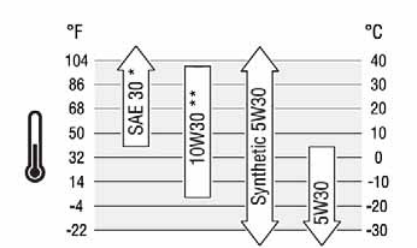
* Below 40°F (4°C) the use of SAE 30 will result in hard starting.
* Above 80°F (27°C) the use of 10W30 may cause increased oil consumption. Check oil level more frequently.
Checking Oil Level
Oil level should be checked prior to each use or at least every 8 hours of operation. Keep oil level maintained.
- Make sure pressure washer is on a level surface.
- Remove oil dipstick and wipe dipstick with clean cloth. Replace and tighten dipstick. Remove and check oil level.
- Verify oil is at FULL mark (top hole) on dipstick. Replace and tighten dipstick.
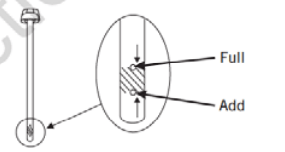
Adding Engine Oil
- Make sure pressure washer is on a level surface.
- Check oil level as described in Checking Oil Level.
- If needed. slowly pour oil into oil fill opening to the FULL mark (top hole) on dipstick. DO NOT overfill. NOTICE: Overfilling with oil could cause the engine to not start, or hard starting.
- DO NOT overfill.
- If over the FULL mark on dipstick. drain oil to reduce oil level to FULL mark on dipstick.
- Replace and tighten dipstick.
Changing Engine Oil
An oil change is not required. Follow the steps below if you want to change the oil.
CAUTION: Avoid prolonged or repeated skin contact with used motor oil.
- Used motor oil has been shown to cause skin cancer in certain laboratory animals.
- Thoroughly wash exposed areas with soap and water.
KEEP OUT OF REACH OF CHILDREN. DON'T POLLUTE, CONSERVE RESOURCES, RETURN USED OIL TO COLLECTION CENTERS.
Change oil while engine is still warm from running, as follows:
- Drain fuel tank by running pressure washer until fuel tank is empty.
- Disconnect spark plug wire and keep it away from spark plug.
- Clean area around oil fill. remove oil fill cap/dipstick. Wipe dipstick clean.
- Tip your pressure washer to drain oil from oil fill into a suitable container making sure you tip your unit away from spark plug. When crankcase is empty, return pressure washer to upright position.
- Slowly pour recommended oil (about 20 oz. (0.6 I) into oil fill opening. Pause to permit oil to settle..Fill to Full mark (top hole) on dipstick.
- Wipe dipstick clean each time oil level is checked. DO NOT overfill.
- Replace and tighten dipstick.
- Wipe up any remaining oil.
- Reconnect spark plug wire to spark plug.
Service Air Cleaner
WARNING! Fuel and its vapors are extremely flammable which could cause burns or fire resulting in death or serious injury. ® Do not start and run engine with air filter removed. Your engine will not run properly and may be damaged if you run it with a dirty air cleaner. Service more often if operating under dirty or dusty conditions.
To service the air cleaner. follow these steps:
1. Pull the latch (A) and open cover (B).
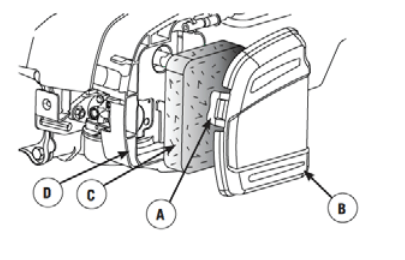
2. Carefully remove air cleaner to prevent debris from falling into carburetor.
3. Wash foam air cleaner (C) in liquid detergent and water. Squeeze dry in a clean cloth.
4. SATURATE foam air cleaner in engine oil and squeeze in a clean cloth to remove excess oil.
5. Reinstall clean or new foam air cleaner in base (D).
6. Close the cover and resecure the latch.
Service Spark Plug
Changing the spark plug will help your engine to start easier and run better.
1. Clean area around spark plug.
2. Remove and inspect spark plug.
3. Replace spark plug if electrodes are pitted. burned or porcelain is cracked. Use the recommended replacement plug. See Specifications.
4. Check electrode gap with wire feeler gauge and reset spark plug gap to recommended gap if necessary (see Specifications).
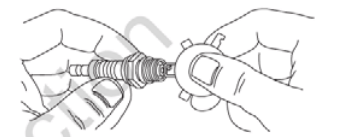
5. Install spark plug and tighten firmly.
Inspect Muffler and Spark Arrester
Inspect the muffler for cracks, corrosion, or other damage. Remove the spark arrester. if equipped. and inspect for damage or carbon blockage. If replacement parts are required. make sure to use only original equipment replacement parts.
WARNING: Exhaust heat/gases could ignite combustibles. structures or damage fuel la tank causing a fire. resulting in death or ( serious injury. Contact with muffler area could cause burns resulting in serious injury.
- DO NOT touch hot parts and AVOID hot exhaust gases.
- Allow equipment to cool before touching.
- Keep at least 5 ft. (1.5 m) of clearance on all sides of pressure washer including overhead.
- It is a violation of California Public Resource Code. Section 4442, to use or operate the engine on any forest-covered. brush-covered. or grass-covered land unless the exhaust system is equipped with a spark arrester, as defined in Section 4442, maintained in effective working order. Other states or federal jurisdictions may have similar laws. Contact the original equipment manutacturer. retailer. or dealer to obtain a spark arrester designed for the exhaust system installed on this engine.
- Replacement parts must be the same and installed in the same position as the original parts.
Air Cooling System
- Over time debris may accumulate in cylinder cooling ins and cannot be observed without partial engine disassembly. For this reason, we recommend you have a qualified service dealer clean the cooling system per recommended intervals (see Maintenance Schedule in beginning of Maintenance section). Equally important is to keep top of engine free from debris. See Clean Debris.
Carburetor Adjustment
- The carburetor on this engine is low emission. It is equipped with a non-adjustable idle mixture valve. Top speed has been set at the factory. If adjustment is required, see an authorized service dealer.
- CAUTION: Excessively high operating speeds could result in minor injury. Excessively low speeds impose a heavy load.
- DO NOT tamper with governor spring, links or other parts to increase engine speed. Pressure washer supplies correct, ted pressure and flow when running at governed speed
- DO NOT modify pressure washer in any way.
After Each Use
Water should not remain in the unit for long periods of time. Sediments or minerals can deposit on pump parts and freeze pump action. Follow these procedures after every use:
1. Shut OFF engine. turn off water supply. point gun in a safe direction. press red button and squeeze trigger to relieve trapped pressure. and let engine cool.
WARNING: The high pressure stream of water that this equipment produces could cut through skin
A and its underlying tissues. resulting in serious injury and possible amputation. Spray gun traps high water pressure. even when engine is stopped and water is disconnected. which could result in serious injury.
- Keep high pressure hose connected to pump and spray gun while system is pressurized.
- ALWAYS point spray gun in safe direction. press red button and squeeze spray gun trigger to release high pressure. every time you stop engine.
2. Disconnect hose from spray gun and high pressure outlet on pump. Drain'water from hose. gun. and nozzle extension. Use a rag to wipe off the hose.
3. Place the spray gun, nozzle extension, and spray tips in the accessory tray. Hang high pressure hose on hook of accessory tray.
4. Empty pump of all pumped liquids by pulling recoil handle about six times. This should remove most liquid in pump.
5. Store unit in a clean, dry area.
6.-If storing for more than 30 days, see Long Term Storage on next page.
WARNING: Fuel and its vapors are extremely flammable and explosive which could cause burns. fire or explosion resulting & in death or serious injury. STORING FUEL OR EQUIPMENT WITH FUEL IN TANK
- Store away from furnaces, stoves, water heaters, clothes dryers, or other appliances that have pilot light or other ignition source because they could ignite fuel vapors.
Storage
Winter Storage
NOTICE: You must protect your unit from freezing temperatures.
- Failure to do so will permanently damage your pump and render your unit inoperable.
- Freeze damage is not covered under warranty.
To protect the unit from freezing temperatures:
- Empty detergent tank as follows:
- Place suitable container under barbed fitting on detergent tank and and remove detergent tube. Remove the tanks cover. tip pressure washer forward slightly and empty tank contents into container.
- Reconnect hose to barbed fitting on tank.
- Add 1 pint (0.5 liter) of clean fresh water to detergent tank and close tanks cover.
- Flush detergent tank by running pressure washer with the black spray tip. Flush until tank is empty.
- Follow steps 1-4 in the previous section After Each Use.
- Use pump saver. Model 6039. to treat pump. This minimizes freeze damage and lubricates pistons and seals.
- If pump saver is not available. connect a 3 ft. (1 m) section of garden hose to water inlet adapter. Pour RV-antifreeze (antifreeze without alcohol)-into hose. Pull recoil handle twice. Disconnect 3 ft. (1 m) hose.
- Store unit in a clean. dry area.
Long Term Storage
- If you do not plan to use the pressure washer for more than 30 days, you must prepare the engine and pump for long term storage.
Protect Fuel System
- Fuel Additive: Fuel can become stale when stored over 30 days. Stale fuel causes acid and gum deposits to form inthe fuel system or on essential carburetor parts. To keep fuel fresh. use Briggs & Stratton Advanced Formula Fuel Treatment & Stabilizer, available wherever Briggs & Stratton genuine service parts are sold.
- There is no need to drain gasoline from the engine if a fuel stabilizer is added according to instructions. Run the engine for 2 minutes to circulate the stabilizer throughout the fuel system before storage.
- If gasoline in the engine has not been treated with a fuel stabilizer, it must be drained into an approved container. Run the engine until it stops from lack of fuel. The use of a fuel stabilizer in the storage container is recommended to maintain freshness.
Protecting the Pump
- To protect the pump from damage caused by mineral deposits or freezing. use Pump Saver. Model 6039. to treat pump. This prevents freeze damage and lubricates pistons and seals.
- NOTICE Pump Saver is available as an optional accessory.
- It is not included with the pressure washer. Contact the nearest authorized service center to purchase Pump Saver.
- NOTICE You must protect your unit from freezing temperatures.
- Failure to do so will permanently damage your pump and render your unit inoperable.
- Freeze damage is not covered under warranty.
- To use Pump Saver. make sure the pressure washer is turned off and disconnected from supply water. Read and follow all instructions and warnings given on the Pump Saver container.
Pump Saver Storage
- On the back of the accessory tray. insert rubber strap into first opening until it locks.
- Set the Pump Saver bottle in the space between the two slots.
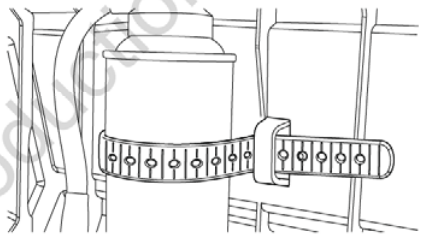
- Wrap the strap over the bottle and feed through the slot and hook onto knob.
Other Storage Tips
- DO NOT store fuel from one season to another unless it has been treated as described in Protect Fuel System.
- Replace fuel container if it starts to rust. Rust and/or dirt in fuel can cause problems if it’s used with this unit.
- Cover unit with a suitable protective cover that does. not retain moisture. WARNING: Storage covers could cause a fire resulting in death or serious injury.
- DO NOT place a storage cover over a hot pressure washer.
- Let equipment cool for a sufficient time before placing the cover on the equipment.
- Store unit in a clean and dry area.
Troubleshooting
1. Pump has following problems: failure to produce pressure, erratic pressure, chattering, loss of pressure, low water volume.
- Low pressure spray tip installed.
- Inadequate water supply.
- Clogged inlet hose screen.
- Spray tip is obstructed.
- Connections leak.
- High pressure hos? or spray gun leaks.
Correction
-
Replace with high pressure spray tip.
-
Provide adequate water flow.
-
Check and clean inlet hose screen.
-
Clean spray tip.
-
Tighten connections or replace o-ring.
-
Replace
2. Detergent fails to mix with spray.
- High pressure spray tip installed.
- Check ball stuck in detergent siphoning system
- Detergent tube/tark is clogged or cracked.
Correction
- Replace with low pressure spray tip.
- Free check ball. See Detergent Siphoning Check Ball
- Clean or replace detergent tube/ tank
3. Engine lacks power; will not start; starts and runs rough or shuts down during operation.
- Engine rocker swith set to OFF (0) position.
- Out of fuel.
- Dirty air cleaner.
- Spark plug wire not connected to spark plug.
Correction
- Set engine rocker switch to ON (I) position.
- Fill fuel tank.
- Clean or replace air cleaner.
- Connect wire to spark plug.
4. Idle contro! not functioning.
- Idle control cable is loose.
Correction: Contact local service facility
For all other issues, see a Briggs & Stratton authorized dealer.
Specifications
- Max Outlet Pressure:. .. 3000°PSI (207 BAR)* @ 2.1 GPM (7.9 liters/min)
- Max Flow Rate: 2.5 GPM (9.5 liters/min)* @ 2400 PSI (165 BAR)
- Water Supply Temperature: .. 100°F (38°C) MAX
- Engine Displacement: 11.58 in3 (190 cc)
- Spark Plug Gap: 0.020 in. (0.50 mm)
- Fuel Capacity: 1.2 Qt. (1.1 Liters)
- Oil Capacity: 20 02 (0.6 L)
Power Ratings: The gross power rating for individual gasoline engine models is labeled in accordance with SAE (Society of Automotive Engineers) code J1940 Small Engine Power & Torque Rating Procedure. and is rated in accordance with SAE 41995. Torque values are derived at 2600 RPM for those engines with “rpm” called out on the label and 3060 RPM for all others; horsepower values are derived at 3600 RPM. The gross power curves can be viewed. Net power values are taken with exhaust and air cleaner installed whereas gross power values are collected without these attachments. Actual gross engine power will be higher than net engine power and is affected by. among other things. ambient operating conditions and engine-to-engine variability. Given the wide array of products on which engines are placed. the gasoline engine may not develop the rated gross power when used in a given piece of power equipment. This difference is due to a variety of factors including. but not limited to. the variety of engine components (air cleaner, exhaust, charging, cooling, carburetor, fuel pump, etc.). application limitations. ambient operating conditions (temperature, humidity, altitude). and engine-to engine variability. Due to manufacturing and capacity limitations. Briggs & Stratton may substitute an engine of higher rated power for this engine.
This pressure washer is rated in accordance to the Pressure Washer Manufacturers Associ: PW101-2010 (Te and R; Performance of Pressure Washers), ion (PWMA) standard
